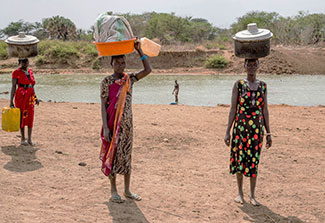Water insecurity can disrupt exclusive breastfeeding
May / June 2021 | Volume 20 Number 3
 UN Photo/JC McIlwaine
Mothers responsible for the household water supply often find it difficult to exclusively breastfeed, a study showed.
UN Photo/JC McIlwaine
Mothers responsible for the household water supply often find it difficult to exclusively breastfeed, a study showed.
By Susan Scutti
Lack of access to clean water can be a barrier to consistent breastfeeding for women who are among the 1.42 billion people that UNICEF estimates live in areas of high or extreme water vulnerability. In a study of individuals knowledgeable about household water management in 16 low- and middle-income countries (LMICs), about 90% reported that water insecurity negatively impacted how infants were fed.
At some sites water insecurity was described as decreasing the frequency of breastfeeding episodes or delaying them, often because women had to leave their infants to collect water, said Arizona State University’s Dr. Roseanne Schuster, lead author on the resulting publication.
“People felt that problems with water can decrease breast milk production, either due to the mother not drinking enough water or from the stress caused by water insecurity,” Schuster said. In many countries, women are typically household water managers, which can be a difficult task to combine with childcare. “There are different ways that water problems affect women, some of this depends on local infrastructure and cultural expectations,” Schuster noted. “One of the most interesting findings was how water was revealed to be integral to motherhood. Responses such as ‘A real mother should always have water at home’ suggest how the burden of problems with water fall on women, and that they too thought of it as their responsibility, even when others could help.”
In the absence of sufficient, clean water, there was also concern that mothers could not properly wash their breasts before feeding. Others felt that breastfeeding women who drank polluted water could pass contaminants on to their babies. Another important finding was that water insecurity meant moms fed their babies in suboptimal ways: “At six months of age, the WHO recommends introducing complementary foods because a baby’s nutritional needs are changing. In particular, infants need nutrient-dense foods at this age since they eat such small quantities,” explained Schuster. Water insecurity hinders the ability to grow nutritious fruits and vegetables and limits cooking in terms of the longer boiling times needed to make foods palatable to infants. Unable to eat preferred foods, there is potential that infants may be missing necessary nutrients during this important period of their development.
Senior study author Dr. Sera Lewise Young, a nutritional anthropologist at Northwestern University, got the idea for this body of work during her previous study of food insecurity in Kenya. Young gave moms cameras and asked them to take pictures of what is important when feeding their kids. “And I got back photos of what you might expect: failed crops and sick chickens and drunken husbands drinking up the food money, but then there were all these pictures of water,” said Young. Some showed how they had to leave their babies with neighbors while they went to queue for water, which prevented exclusive breastfeeding. One memorable image showed a jug of murky water taken from a river into which sewage from a prison was dumped. The woman who took the shot explained: “This is a picture of the water I use for my child. I can either buy food and use this water or I can buy water and have no money for food.”
Having seen through other mothers’ eyes, Young knew she needed to quantify water insecurity. She worked with a consortium of global collaborators to develop the first validated, cross-culturally equivalent tool to assess water insecurity at the household level based on data from 28 LMICs. The resulting tool, the
Household Water Insecurity Experiences Scale (HWISE), has been adopted by the World Bank, UNICEF and others, Young reported. “Organizations are recognizing that the measurement of experiences of water insecurity is as important as measuring food insecurity.”
The studies mentioned above were funded in part by the NIH’s National Institute of Environmental Health Sciences, the National Institute of Mental Health and Fogarty.
More Information
To view Adobe PDF files,
download current, free accessible plug-ins from Adobe's website.
Related Global Health Research Topics